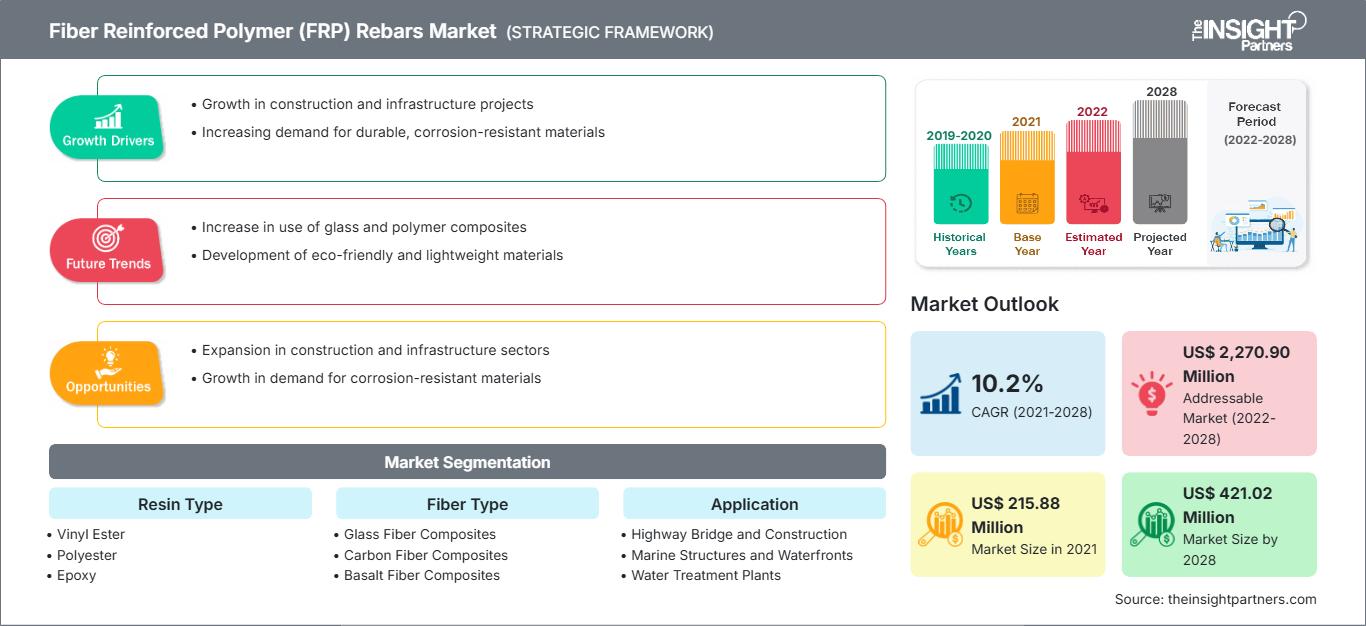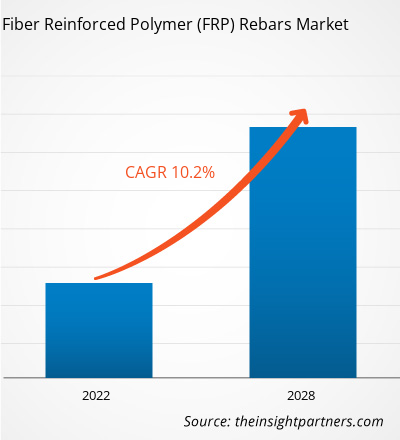Se prevé que el mercado de barras de refuerzo de polímero reforzado con fibra (FRP) crezca de 215,88 millones de dólares estadounidenses en 2021 a 421,02 millones de dólares estadounidenses en 2028; se estima que crecerá a una tasa de crecimiento anual compuesta (TCAC) del 10,2% entre 2022 y 2028.
Dado que el hormigón es resistente a la compresión y débil a la tracción, se suele reforzar para crear un material de construcción resistente tanto a la tracción como a la compresión. Este refuerzo tradicionalmente consiste en acero debido a su bajo coste, alta resistencia y gran elasticidad. Sin embargo, la corrosión del acero puede costar a gobiernos y propietarios de activos miles de millones de dólares en gastos de mantenimiento para reemplazar o reparar infraestructuras antiguas. Existen pocas alternativas para los materiales de refuerzo del hormigón que puedan utilizarse para prevenir la corrosión. Por ejemplo, algunos fabricantes ofrecen barras de acero inoxidable; sin embargo, las barras de polímero reforzado con fibra (PRF) pueden servir como una alternativa no corrosiva a las barras de acero convencionales para el refuerzo del hormigón. Estas barras de PRFV se fabrican con una matriz polimérica combinada con fibras de vidrio, carbono o basalto. Estos materiales no se oxidan, son mucho más ligeros que el acero, no transmiten el calor y son casi cuatro veces más resistentes a la tracción. Su capacidad anticorrosiva convierte al polímero reforzado con fibra en la mejor alternativa para diversas aplicaciones en la construcción, tales como muros de contención, muelles, embarcaderos, dársenas, cajones, cubiertas, mamparos, pilotes, canales, plataformas marinas, piscinas y acuarios.
Además, en aplicaciones sensibles a la radiación electromagnética, las propiedades no conductoras del vidrio y el polímero de las barras de refuerzo de FRP impiden la transmisión de corriente, la atracción de rayos y la interferencia con el funcionamiento de los dispositivos eléctricos cercanos. Esto convierte al polímero reforzado con fibra en una alternativa más segura que el acero en plantas de fundición de aluminio y cobre, torres de control de aeropuertos, centrales nucleares, estructuras militares especializadas, torres de transmisión eléctrica y telefónica, pozos de registro con equipos eléctricos o telefónicos y hospitales con equipos de resonancia magnética (RM).
Obtendrá personalización gratuita de cualquier informe, incluyendo partes de este informe, análisis a nivel de país y paquetes de datos de Excel. Además, podrá aprovechar excelentes ofertas y descuentos para empresas emergentes y universidades.
Mercado de barras de refuerzo de polímero reforzado con fibra (FRP): Perspectivas estratégicas

-
Obtenga las principales tendencias clave del mercado de este informe.Esta muestra GRATUITA incluirá análisis de datos, desde tendencias del mercado hasta estimaciones y pronósticos.
Perspectivas del mercado
El aumento de la actividad de la construcción impulsa el crecimiento del mercado de barras de refuerzo de polímero reforzado con fibra (FRP).
La industria de la construcción es uno de los principales motores del desarrollo económico mundial. Su rápido crecimiento se debe al creciente apoyo gubernamental al desarrollo de infraestructuras a nivel global. Por ejemplo, India planeó invertir 1,4 billones de dólares en infraestructuras a través del Plan Nacional de Infraestructuras entre 2019 y 2023. Este plan incluye infraestructuras como centrales eléctricas, puentes, presas, carreteras y desarrollo urbano. Gracias a sus ventajosas propiedades, como su alta resistencia, tolerancia a las heladas y a las sales de deshielo, y tiempos de instalación reducidos con mínima interferencia con el tráfico, los polímeros reforzados con fibra (PRF) se han consolidado como valiosos materiales de construcción sustitutos para estructuras de puentes. Se espera que estas iniciativas gubernamentales impulsen el crecimiento del mercado de barras de refuerzo de PRFV (polímero reforzado con fibra).
Información sobre los tipos de resina
Según el tipo de resina, el mercado global de barras de refuerzo de polímero reforzado con fibra (PRFV) se segmenta en viniléster, poliéster, epoxi y otros. En 2021, el segmento de viniléster ostentó la mayor cuota de mercado. Las resinas de viniléster se caracterizan por su alta resistencia mecánica, su elevada resistencia a la corrosión, combustibles, productos químicos y vapores, así como por su tenacidad mecánica. Poseen gran durabilidad, resistencia al calor y una elevada elongación a la tracción. Esta resina puede impregnarse con fibra de vidrio corta o fibra de carbono para producir barras de refuerzo de PRFV. La mayoría de los fabricantes de barras de refuerzo de polímero reforzado con fibra utilizan resina de viniléster. La rentabilidad del viniléster ha impulsado el crecimiento de este segmento.
Owens Corning; KODIAC Fiberglass Rebar; MARSHALL COMPOSITE TECHNOLOGIES, LLC; TUF-BAR; Armastek USA; Pultron Composites; FiRep Inc.; PULTRALL, Inc.; Schock Bauteile GmbH; y Dextra Group se encuentran entre los principales actores del mercado mundial de barras de refuerzo de polímero reforzado con fibra (PRF). Las empresas líderes adoptan estrategias como fusiones y adquisiciones, así como el lanzamiento de nuevos productos, para expandir su presencia geográfica y su cartera de clientes. Por ejemplo, Pultron Composites se asoció con Saudi Aramco, la principal petrolera de Arabia Saudita, para ampliar sus instalaciones de producción de barras de refuerzo de polímero reforzado con fibra de vidrio (PRFV) en el país.
Barras de refuerzo de polímero reforzado con fibra (FRP)
Perspectivas regionales del mercado de barras de refuerzo de polímero reforzado con fibra (FRP)
Los analistas de The Insight Partners han explicado en detalle las tendencias regionales y los factores que influyen en el mercado de barras de refuerzo de polímero reforzado con fibra (FRP) durante el período de previsión. Esta sección también analiza los segmentos y la geografía del mercado de barras de refuerzo de polímero reforzado con fibra (FRP) en Norteamérica, Europa, Asia Pacífico, Oriente Medio y África, y Sudamérica y Centroamérica.
Alcance del informe de mercado de barras de refuerzo de polímero reforzado con fibra (FRP)
| Atributo del informe | Detalles |
|---|---|
| Tamaño del mercado en 2021 | 215,88 millones de dólares estadounidenses |
| Tamaño del mercado para 2028 | 421,02 millones de dólares estadounidenses |
| Tasa de crecimiento anual compuesto global (2021 - 2028) | 10,2% |
| Datos históricos | 2019-2020 |
| período de previsión | 2022-2028 |
| Segmentos cubiertos |
Por tipo de resina
|
| Regiones y países cubiertos |
América del norte
|
| Líderes del mercado y perfiles de empresas clave |
|
Densidad de los actores del mercado de barras de refuerzo de polímero reforzado con fibra (FRP): comprensión de su impacto en la dinámica empresarial
El mercado de barras de refuerzo de polímero reforzado con fibra (FRP) está creciendo rápidamente, impulsado por la creciente demanda de los usuarios finales debido a factores como la evolución de las preferencias de los consumidores, los avances tecnológicos y una mayor conciencia de los beneficios del producto. A medida que aumenta la demanda, las empresas amplían su oferta, innovan para satisfacer las necesidades de los consumidores y aprovechan las nuevas tendencias, lo que impulsa aún más el crecimiento del mercado.

- Obtenga una visión general de los principales actores del mercado de barras de refuerzo de polímero reforzado con fibra (FRP).
Reportajes destacados
- Tendencias progresivas en la industria de barras de refuerzo de polímero reforzado con fibra (FRP) para ayudar a los participantes a desarrollar estrategias efectivas a largo plazo.
- Estrategias de crecimiento empresarial adoptadas por las empresas para asegurar el crecimiento en mercados desarrollados y en desarrollo
- Análisis cuantitativo del mercado mundial de barras de refuerzo de polímero reforzado con fibra (FRP) de 2022 a 2028
- Estimación de la demanda de barras de refuerzo de polímero reforzado con fibra (FRP)
- El análisis de Porter ilustra la eficacia de compradores y proveedores que operan en la industria para predecir el crecimiento del mercado.
- Últimos avances para comprender el panorama competitivo del mercado y la demanda de barras de refuerzo de polímero reforzado con fibra (FRP).
- Tendencias y perspectivas del mercado, y factores que impulsan y restringen el crecimiento del mercado mundial de barras de refuerzo de polímero reforzado con fibra (FRP)
- Comprender las estrategias que sustentan el interés comercial con respecto al crecimiento del mercado mundial de barras de refuerzo de polímero reforzado con fibra (FRP), lo que ayuda en el proceso de toma de decisiones.
- Tamaño del mercado mundial de barras de refuerzo de polímero reforzado con fibra (FRP) en varios nodos del mercado
- Descripción general detallada y segmentación del mercado mundial de barras de refuerzo de polímero reforzado con fibra (FRP) y su dinámica industrial.
- Tamaño del mercado mundial de barras de refuerzo de polímero reforzado con fibra (FRP) en diversas regiones con prometedoras oportunidades de crecimiento
El informe "Análisis del mercado de barras de refuerzo de polímero reforzado con fibra (FRP) hasta 2028" es un estudio especializado y exhaustivo de la industria química y de materiales, centrado en el análisis de tendencias del mercado de barras de refuerzo de polímero reforzado con fibra (FRP). El informe ofrece una visión general del mercado con una segmentación detallada. El mercado de barras de refuerzo de polímero reforzado con fibra (FRP) se segmenta por tipo de resina, tipo de fibra, aplicación y geografía. Según el tipo de resina, el mercado se segmenta en viniléster, poliéster, epoxi y otros. Según el tipo de fibra, el mercado se segmenta en compuestos de fibra de vidrio, compuestos de fibra de carbono y compuestos de fibra de basalto. Según la aplicación, el mercado se segmenta en construcción de puentes y carreteras, estructuras marinas y zonas costeras, plantas de tratamiento de agua y otros. Según la geografía, el mercado se segmenta en cinco regiones principales: Norteamérica, Europa, Asia Pacífico, Oriente Medio y África, y Sudamérica y Centroamérica. En 2021, Norteamérica dominó el mercado de barras de refuerzo de polímero reforzado con fibra (FRP). Sin embargo, se espera que Asia Pacífico registre la mayor tasa de crecimiento anual compuesto (CAGR) del mercado durante el período de pronóstico.
- Análisis histórico (2 años), año base, pronóstico (7 años) con CAGR
- Análisis PEST y FODA
- Tamaño del mercado, valor/volumen: global, regional y nacional
- Industria y panorama competitivo
- Conjunto de datos de Excel
Informes recientes
Testimonios
Razón para comprar
- Toma de decisiones informada
- Comprensión de la dinámica del mercado
- Análisis competitivo
- Información sobre clientes
- Pronósticos del mercado
- Mitigación de riesgos
- Planificación estratégica
- Justificación de la inversión
- Identificación de mercados emergentes
- Mejora de las estrategias de marketing
- Impulso de la eficiencia operativa
- Alineación con las tendencias regulatorias






















 Obtenga una muestra gratuita para - Mercado de varillas de refuerzo de polímero reforzado con fibra (PRFV)
Obtenga una muestra gratuita para - Mercado de varillas de refuerzo de polímero reforzado con fibra (PRFV)